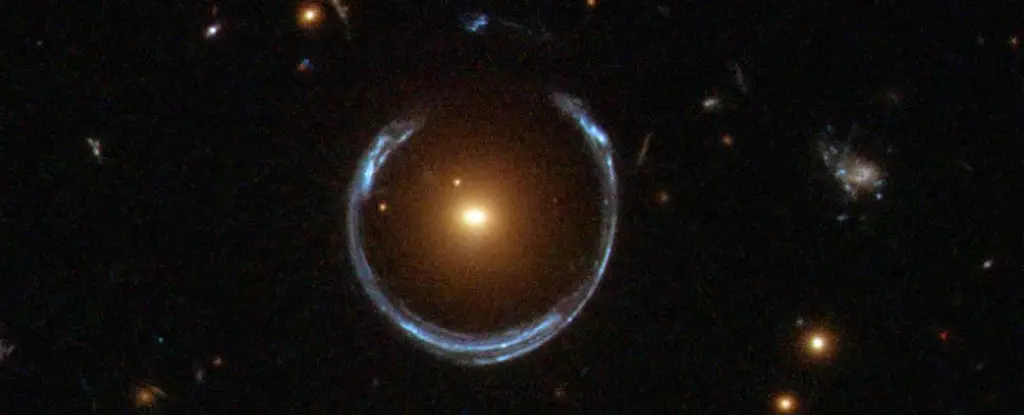The astronomical community is brimming with discussions about groundbreaking discoveries, and the Cosmic Horseshoe, identified in 2007, has emerged as a phenomenal case study of gravitational lensing and the intricate relationships between galaxies. This unusual formation, located a staggering 5.5 billion light-years away from Earth, is more than just a visual marvel; it harbors profound implications for our understanding of black holes and galaxy formation. At its heart lies an Ultra-Massive Black Hole (UMBH) with an extraordinary mass of 36 billion solar masses, shattering existing perceptions of black hole scale and formation.
The Cosmic Horseshoe is a remarkable example of gravitational lensing, a phenomenon predicted as early as the 1930s by Albert Einstein. When a massive foreground galaxy aligns perfectly with a more distant background galaxy, the gravity of the foreground galaxy bends and amplifies the light from the background galaxy. This specific alignment creates what is known as an Einstein Ring, a visual representation of the extraordinary gravitational effects at play. The galaxy responsible for this lensing effect is called LRG 3-757, a Luminous Red Galaxy characterized by its intense infrared brightness and enormous mass—approximately 100 times that of the Milky Way.
The discovery of LRG 3-757’s UMBH has sparked discussions among astronomers about the nature and classification of black holes particularly in relation to their host galaxies. Although there’s no strict threshold for defining an UMBH, they are generally classified as supermassive black holes exceeding 5 billion solar masses. The staggering mass of the UMBH found in the Cosmic Horseshoe raises questions about its formation and growth relative to the galaxy that contains it.
Central to this investigation is the MBH-sigma relation, which posits a strong correlation between the mass of a supermassive black hole and the velocity dispersion of stars in the galactic bulge. This relationship suggests that the evolutionary pathways of galaxies and their central black holes are intricately linked. The greater the velocity dispersion of the stars—indicative of their speed and random motion—the more massive the black hole is expected to be.
However, the UMBH in the Cosmic Horseshoe deviates significantly from the MBH-sigma relation, suggesting a divergence in the evolutionary models that govern the relationship between such massive black holes and their galaxies. This deviation hints at unique historical processes that might have influenced LRG 3-757’s stellar dynamics. For instance, past mergers with other galaxies could have altered the velocity dispersion of stars, thereby impacting this significant relationship. This concept aligns with the idea of fossil groups—large clusters of galaxies that have undergone minimal new star formation and feature a few extremely large galaxies at their centers.
Mergers between colossal galaxies potentially explain the UMBH’s mass while affecting the stellar velocity dispersion. When supermassive black holes interact, they can expel stars from the galaxy’s core through a process called “scouring,” leading to lower velocity dispersion while maintaining their own significant mass. Additionally, the feedback from Active Galactic Nuclei (AGN)—which are powered by black holes actively accreting material—can suppress star formation and alter the central structure of the galaxy as well.
These mechanisms introduce a layer of complexity to our understanding of black hole and galaxy formation as they may drive the discrepancies seen in black hole mass versus velocity dispersion at higher scales. The research underscores our limited understanding of how supermassive black holes evolve and interact with their host galaxies over cosmic timescales.
The recent findings, presented by lead author Carlos Melo-Carneiro in a paper available on arxiv.org, signify a stepping stone toward deeper explorations of these enigmatic celestial bodies. As advancements in observational technology continue, such as those anticipated from the Euclid mission and the Extremely Large Telescope (ELT), astronomers will be better equipped to probe the velocities and mass distributions of stars surrounding ultra-massive black holes.
These upcoming missions aim to unveil hundreds of thousands of new gravitational lenses, enhancing our understanding of the universe’s structure and the interplay between dark matter and baryonic matter. The increasing focus on enigmatic systems like the Cosmic Horseshoe reveals the cosmos as an intricate tapestry, where every thread—every galaxy and black hole—contributes to the grand narrative of cosmic evolution.
The investigation of the UMBH within the Cosmic Horseshoe not only challenges prevailing theories regarding black hole formation and growth but also expands our horizons, inviting us to explore the more intricate landscapes of galaxy evolution and the universe. The enigma of how the universe weaves together massive structures remains an enduring quest for astronomers, holding profound implications for our existential understanding.


Leave a Reply